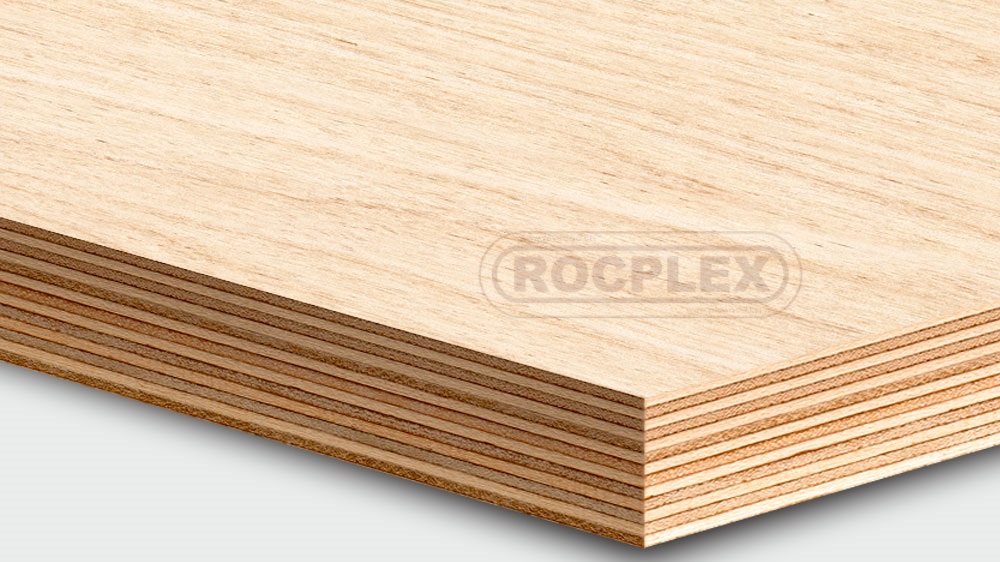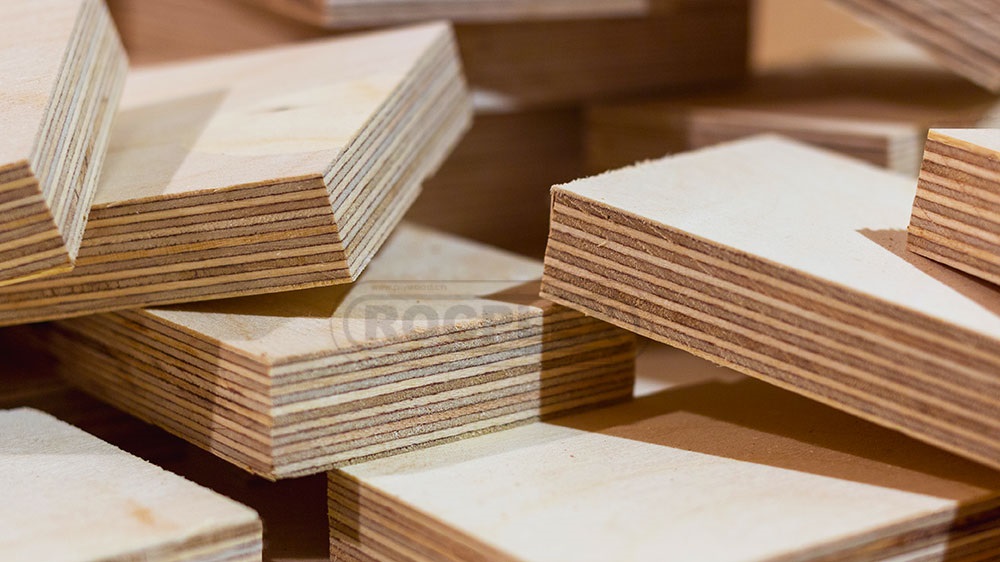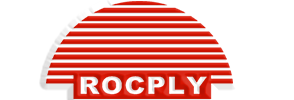What is plywood?
Plywood is a strong, multi-layer wood panel widely used in construction, furniture, and packaging. It’s made by bonding veneer sheets with waterproof glue. ROCPLY plywood delivers excellent strength, surface quality, and reusability. Builders rely on plywood for flooring, roofing, formwork, and furniture. Whether it’s hardwood plywood or film faced plywood, ROCPLY ensures performance and durability. With sealed edges and precision engineering, our panels are ideal for both light-duty and heavy-duty applications across global industries.

Why Plywood Remains the Backbone of Building and Furniture
Plywood has been a changer in construction and manufacturing for decades. It offers a mix of strength, versatility, and affordability.
Unlike solid wood, plywood resists warping and cracking. It is lighter, easier to work with, and ideal for structural and decorative use. From skyscrapers to kitchen cabinets, plywood plays a role in every step.
ROCPLY produces plywood solutions that meet the specific needs of global buyers. Whether for high-load formwork or decorative interiors, our plywood panels deliver results.
What is Plywood Made From?
Plywood consists of thin layers of wood, called veneers. These are glued together with their grain directions alternated.
This cross-layering provides greater stability and strength. The outer layers define the surface quality, while the inner cores give structural integrity.
Types of wood used in ROCPLY plywood include:
Eucalyptus – Strong and dense, ideal for construction
Poplar – Lightweight and economical
Birch – High-quality finish for interior or decorative uses
Hardwood mix – Balanced strength and cost
All veneers are bonded using waterproof resin glue. ROCPLY uses A-bond or WBP (Water Boil Proof) adhesive depending on the application.
Different Types of Plywood Available
There are many types of plywood. Each one serves a unique function across construction and manufacturing industries.
1. Form Plywood (Formply)
Used in concrete formwork. Has a film coating for smooth finishes and multiple reuses. ROCPLY form plywood is edge-sealed and reinforced for heavy loads.
2. Hardwood Plywood
Made with dense wood cores for added strength. Suitable for structural panels, flooring, and industrial use.
3. Marine Plywood
Water-resistant and durable, even in submerged conditions. Used in boats, bathrooms, and coastal construction.
4. Film Faced Plywood
Coated with phenolic film. Ideal for shuttering, scaffolding decks, and outdoor structures.
5. Commercial Plywood
General-purpose board for furniture, interiors, partitions, and packaging.
Each type serves specific industries and has its own standards. ROCPLY provides full product customization for buyers worldwide.
How Is Plywood Used in Construction?
Plywood plays several key roles in construction:
Concrete Formwork – ROCPLY film faced plywood is reusable, waterproof, and creates a smooth concrete surface.
Roof and Floor Substrates – Offers support and rigidity under roofing materials and flooring finishes.
Wall Sheathing – Acts as a structural base in timber-framed buildings.
Scaffolding Platforms – Anti-slip plywood ensures worker safety.
Temporary Fencing and Hoarding – Durable and easy to install.
Contractors choose plywood because it balances cost and performance. ROCPLY ensures every panel is up to spec for construction environments.
Furniture and Interior Uses of Plywood
Beyond the jobsite, plywood is a favorite in furniture production. Its smooth finish and ease of cutting make it perfect for:
Wardrobes, cabinets, and drawers
Tabletops and shelving
Door skins and laminated panels
Wall panels and ceilings
Interior designers prefer plywood for its consistent appearance and easy finish options. ROCPLY plywood can be laminated, veneered, or UV-coated for ready-to-use aesthetics.
Advantages of Plywood Over Solid Wood
| Feature | Solid Wood | Plywood (ROCPLY) |
| Warping Resistance | Prone to bending | Stable and cross-laminated |
| Cost | Higher | More affordable per sq. m. |
| Sheet Size | Limited | Large panels available |
| Versatility | Limited uses | Construction + Furniture |
| Surface Finish | Requires sanding | Smooth or film-coated |
ROCPLY enhances these benefits by using calibrated cores, edge sealing, and moisture testing.
Plywood Thicknesses and Grades
Plywood comes in many thicknesses to suit various applications. Choosing the correct panel depends on structural needs, appearance, and project type.
Common Thicknesses:
| Thickness (mm) | Common Use |
| 4 – 6mm | Back panels, ceiling, curved partitions |
| 9 – 12mm | Furniture, packaging, interior paneling |
| 15 – 18mm | Flooring, roofing, wall cladding |
| 21 – 25mm | Formwork, scaffolding, heavy load surfaces |
ROCPLY manufactures all standard and custom thicknesses. Each sheet is precision-calibrated for uniform performance.
Grades of Plywood:
Plywood grades indicate surface quality and intended use.
AA / AB Grade – Top-quality face for decorative applications
BB / CC Grade – Standard utility and structural purposes
CDX / CD Grade – Used for construction sheathing or concrete forming
F17 / F22 Structural Grades – Certified for high-load construction tasks
ROCPLY plywood is graded and tested according to EN, AS/NZS, and other relevant standards.
How ROCPLY Plywood Is Made
Our plywood production process ensures consistency, durability, and value for every panel.
Step-by-Step:
Log Selection
Only high-quality eucalyptus, poplar, or birch logs are used.
Peeling and Veneer Grading
Logs are rotary peeled and veneers sorted by thickness and quality.
Drying and Assembly
Veneers are kiln-dried, glued, and laid crosswise for strength.
Hot Pressing
Panels are compressed under heat to activate resin and form strong bonds.
Trimming and Sanding
Sheets are cut to size, sanded flat, and inspected for defects.
Film Coating / Edge Sealing (Optional)
Depending on the product type, sheets may be coated with phenolic film and edges painted.
Final Inspection and Packing
Each ROCPLY panel is tested for moisture, thickness, bonding, and finish before packing.
Frequently Asked Questions About Plywood
Is plywood waterproof?
Some plywood types are waterproof. ROCPLY uses WBP or A-bond glue for marine and formwork plywood, making them water-resistant.
How strong is plywood?
Plywood is stronger than solid wood in many applications. The cross-layer structure resists bending, warping, and splitting.
Can plywood be recycled?
Yes. ROCPLY plywood is made from renewable wood. It can be reused, repurposed, or safely recycled after its useful life.
What sizes are available?
The most common size is 1220mm x 2440mm (4’x8′). ROCPLY offers custom sizing and edge branding based on order requirements.
What certifications does ROCPLY provide?
We offer:
FSC® and PEFC™ chain-of-custody certification
AS/NZS 2269 / 6669 for structural plywood
EN 13986 / EN 314 for European compliance
ISO 9001 for factory quality management systems

Global Applications and Market Insights
ROCPLY exports plywood to over 50 countries. Each market values specific features:
Australia & New Zealand – AS/NZS-certified structural formply and F17 plywood
Middle East – Film faced plywood for slabs and precast molds
Southeast Asia – Poplar core commercial plywood for furniture and packaging
Europe – Birch plywood for interiors and laminated panels
South America – General construction-grade panels for formwork and sheathing
Buyers worldwide value ROCPLY’s stable supply, strict QC, and brand support.
Environmental Responsibility and Sustainability
ROCPLY actively reduces its environmental footprint. We ensure our operations meet green standards, including:
FSC-certified sources for raw materials
E0 and E1 low-emission adhesives
Energy-efficient kilns to reduce CO₂
Optimized panel cutting to reduce waste
Recyclable export packaging
We support clients working toward LEED, Green Star, and BREEAM certification projects.
Choosing the Right Plywood for Your Project
Consider these when selecting the right panel:
| Project Type | Recommended ROCPLY Product |
| Concrete formwork | Film Faced Form Plywood |
| Structural flooring | F17 or F22 Structural Plywood |
| Interior furniture | BB/CC Commercial Plywood |
| Wet-area cabinets | Marine Grade Plywood |
| Decorative wall panels | Veneer or Fancy Plywood Series |
Our team provides full technical support to help clients choose the best fit.
Global Market Trends in the Plywood Industry
Plywood demand has grown rapidly over the past decade. Both developed and emerging markets are adopting plywood for structural and decorative use.
Current Trends:
Sustainability is a major driver. Buyers prefer FSC-certified or low-emission panels.
Prefabrication and modular construction use plywood for walls, floors, and even furniture systems.
High-rise formwork demands consistent quality and surface finish — an advantage of ROCPLY formply.
Digital manufacturing (CNC cutting, lamination) depends on dimensionally stable plywood for tight tolerances.
Packaging industries are switching from solid wood to plywood for lightweight crates and pallets.
ROCPLY adapts to these shifts by offering custom-engineered solutions with strict quality controls and global certifications.
ROCPLY Logistics, Export, and After-Sales Services
With customers in over 50 countries, ROCPLY is a trusted partner in international plywood supply.
Export Services:
Mixed container loading for plywood, LVL, and other panels
Custom branding with logos, edge printing, and pallet markings
Moisture-controlled packaging to protect during sea freight
Certificate of Origin, COA, and FSC® documentation support
On-time delivery with flexible lead times and shipment tracking
Our logistics team ensures smooth customs clearance and port handling. ROCPLY also provides local inventory plans for frequent buyers.
How to Store and Maintain Plywood Panels
Proper handling extends plywood lifespan and performance.
Storage Tips:
Keep panels flat and off the ground using pallets.
Cover stacks with tarps or film to protect from moisture and dust.
Store indoors or under ventilated shelters.
Don’t lean panels against walls to avoid warping.
Use a forklift or side-loader to handle full bundles safely.
For film faced or form plywood, apply form oil before each concrete pour. Clean after use and reseal any cut edges with waterproof paint.
Common Mistakes When Using Plywood
Avoid these to ensure safety and product value:
Using the wrong grade for the job
For example, using commercial plywood in a structural role may cause failure.
Leaving panels exposed to sun/rain
Even waterproof glue has limits. Exposure shortens lifespan.
Skipping edge sealing after cuts
Unsealed edges can absorb moisture, leading to delamination.
Using damaged panels in load-bearing structures
Always inspect panels for cracks or delamination before use.
Incorrect nail/screw usage
Choose the correct fastener spacing and type. Pre-drill if necessary.
ROCPLY offers usage guidelines and technical data sheets to help you avoid these issues.

About Plywood Sheets and Why ROCPLY Stands Out
Plywood is one of the most versatile and reliable building materials in the world. It supports skyscrapers, furnishes homes, and packages global trade.
ROCPLY is committed to providing high-quality plywood solutions — whether for concrete forming, high-end furniture, or heavy-duty transport crates.
ROCPLY Benefits Recap:
Top-grade veneer selection and bonding
Waterproof and reusable film face options
Precision thickness and flatness for CNC and cabinetry
Flexible formats for custom projects
Certified sustainable production processes
We serve wholesalers, builders, developers, and manufacturers who need strength, stability, and service they can trust.
Post time: Aug-11-2025

